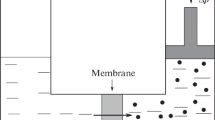Abstract
This presentation claims that a fall in free energy, which is the rigorous thermodynamic criterion for a spontaneous change, cannot be the drive in osmotic processes. Our models and theories require the introduction of a parameter that explicitly represents structure in liquids, which until now has had no place in the thermodynamic description of solutions. This lack is surprising, when one remembers that experimental results from the broad range of fields of colloid, clay and biological sciences have clearly established the marked effect of solutes on the structural properties of water, globally called ‘hydration phenomena’.
The introduction of such a parameter can help explain the direction in which energy flows during osmosis, which has been so puzzling to those of us interested in mechanism since the time of Pfeffer, more than a century ago. Further, elementary work cycles show, that changes in this parameter correspond to changes in the energy associated with solvent structure which can be used to produce useful work. The ability of osmotic systems to do work is familiar to all of us (indeed, a nuisance to many!), and is the basis of cytomechanics, i.e., the physical processes observed in the living cell. The fact that it still has no satisfactory explanation is clearly an urgent problem for us all.
Similar content being viewed by others
References
Hawking, S.W.:A brief History of Time, Bantam Books, London, 1991, pp. 121–150.
Mauro, A.: Osmotic flow in a rigid porous membrane.Science 149 (1965), 867–869.
Watterson, J.G.: Model for a co-operative structure wave, in F. Franks and S.F. Mathias (eds.),Biophysics of Water, Wiley, N.Y., 1982, pp. 144–147.
Watterson, J.G.: Does solvent structure underlie osmotic mechanisms?Phys. Chem. Liq. 16 (1987), 313–316.
Kaivarainen, A.I.: Theory of condenses state as a heirarchial system of quasiparticles formed by phonons and three-dimensional de Broglie waves of molecules.J. Mol. Liq. 41 (1989), 53–72.
Stuart, C.I.J.M., Takehashi, Y., and Umezawa, H.:Mixed system brain dynamics.Found. Phys. 9 (1979), 301–321.
Jibu, M. and Yasue, K.: A physical picture of Umezawa's quantum brain dynamics, in R. Trappl (ed.),Cybernetics and systems research, World Scientific, London, 1992, pp. 1–2.
Watterson, J.G.: The interactions of water and protein in cellular function.Prog. Molec. Subcell. Biol. 12 (1991), 113–134.
Jibu, M., Hagan, S., Hameroff, S.R., Pribram, K.H., and Yasue, K.: Quantum optical coherence in cytoskeletal microtubules.Bio Systems 32 (1994), 195–209.
Watterson, J.G.: Wave model of liquid structure in clay hydration.Clays Clay Miner. 37 (1989), 285–286.
Author information
Authors and Affiliations
Rights and permissions
About this article
Cite this article
Watterson, J.G. What drives osmosis?. J Biol Phys 21, 1–9 (1995). https://doi.org/10.1007/BF00701005
Received:
Accepted:
Issue Date:
DOI: https://doi.org/10.1007/BF00701005




